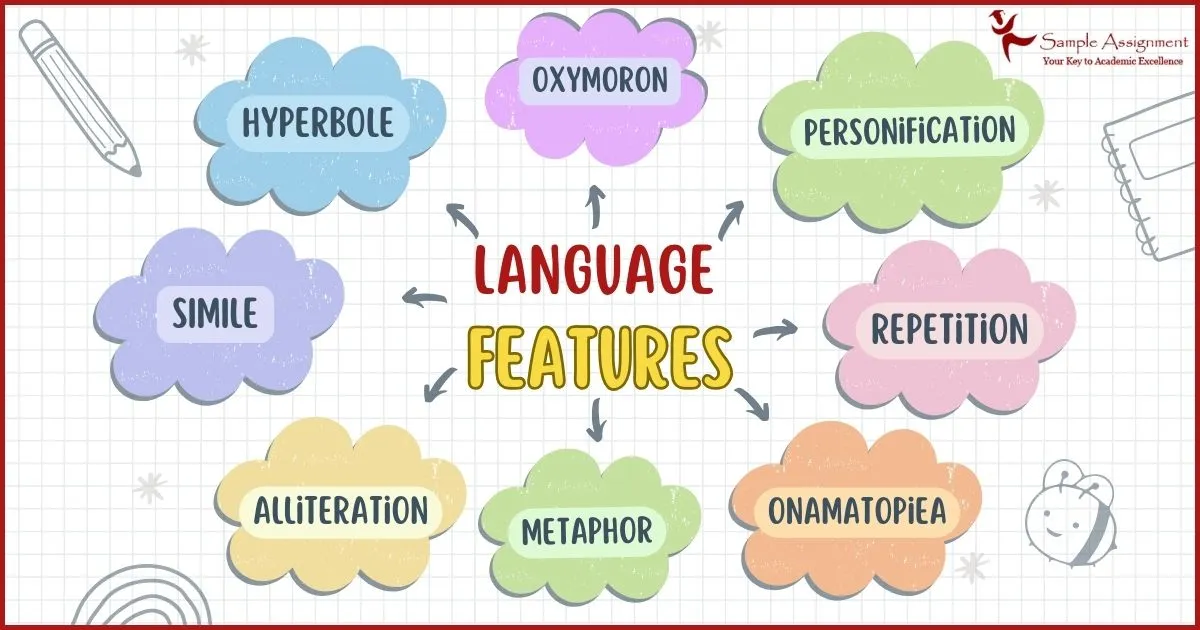
Language features are so important in transferring information, substance, and purpose that it is critical to employ all of its aspects appropriately, including simile and figurative language. Various language qualities impact discourse. Hence, choosing the proper language elements to establish form and produce content is crucial. Language features make it easier to comprehend and write tales or articles.
Language Features have several characteristics. There is no one correct method to say what you want to convey. When you can access a list of language characteristics, your ability to express yourself expands. These language elements include metaphors, alliteration, similes, and so on.
If you are unaware of these words, you are likely living under a stone. Do not worry; we are here to help. We selected the most significant language features and created a simple guidebook.
So, what are you waiting for? Type assignment help India on Google and connect with us to get an overview of these features.
Overview of Language Features
What are Language features? It is a regular inquiry every writer receives. The language has literary instruments for language assessment. Language Features Techniques make it easy to understand what the author is saying. The writer frequently utilizes language methods to convey his message. In addition, the authors use tactics such as language selection, tone, grammatical structures, and turns of phrase.
Active listening promotes effective and efficient communication skills. It is a form of listening approach. It is effective for guidance, education, and resolving disputes. Furthermore, the listener needs to pay close attention to understand what is being said, reply, and remember it. An adjective is a phrase that describes a noun's properties.
A favourable term is an ordinary word that only highlights the virtues of people, societies, or everyday objects. Expressive adjectives refer to nouns and pronouns. Descriptive adjectives include words like attractive, hilarious, tall, annoying, noisy, and spectacular. Alliterations occur when the same word or letter appears many times at the start of two or more connected words.
Examples of Language Features:
Figurative and colloquial language, alliteration, metaphor, simile, consonance, and other language features efficiently communicate content and information.
It is commonly utilized in poetry and music and does not correspond to the ordinary meanings we use in everyday life. It makes the information more engaging. Figurative Language includes similes, metaphors, hyperbole, etc.
- Colloquial Language: Relax, take a chill pill, and other conversational terms are examples of informal Language.
- Dialogue: Communication between two or more persons is essential in theatre and includes remarks and challenges.
- Alliteration: In this language, the first letter of every word is repeated and followed by the following one in a phrase.
Sentence structure, punctuation, nouns, vocabulary, phrases, and so on are examples of language elements that contribute to communication meaning. Different Language Features used in connection impact the debate. Therefore, selecting the proper language characteristics to define shape and create content is crucial.
Language Features List

Some popular Language Features are explained below in the Language Features List:
- Allegory
- Alliteration
- Allusion
- Analogy
- Anaphora
- Antithesis
- Assonance
- Emotive language
- Dramatic irony
- Euphemism
- Homonym
- Imagery
- Hyperbole
- Mood and tone
- Litotes
- Metaphor
- Oxymoron
- Pathos
- Satire
- Zeugma
- Pun
- Symbolism
Over history, language has been regarded as the most practical form of communication. Language has always been the most critical aspect of communication as it has progressed, and various individuals utilize different styles and tones.
People use language to describe emotions and communicate their ideas. Language allows us to express ourselves in two ways verbally and written. Both methods facilitate communication between two or more persons.
Each language has unique styles, tones, and characteristics. To master the language, you must adhere to certain tones, characteristics, and styles, whether speaking or writing. Therefore, one must have fundamental language skills to talk or write fluently. Furthermore, communication requires the expression of sentiments to another person, and language serves as the means.
Language's principal goal is to assist readers, and listeners in understanding what the writer or speaker is trying to say. A person transmitting his message to the readers utilizes language as a weapon to express his emotions and ideas. To accomplish this, he employs a variety of styles, approaches, and techniques to affect the audience. The language function now allows you to easily distinguish between distinct writing styles and language strategies and understand what the individual is saying.
Currently, people accept two sorts of language characteristics. The language features are as follows:
Persuasive language:
Using this language characteristic, the writer attempts to convince and influence the reader to make particular judgments.
- Evidence: The writing in this section is often paraphrased to meet audience needs.
- Inclusive language: This category includes words like "us, we, and they". The author seeks to utilize these statements to excite and inspire his readers. Political leaders frequently utilize this.
- Exclusive language: Words like "them, house, they" are examples of exclusive language. The author uses these phrases to identify a subset of persons outside a group.
- Rhetorical language: These lines are meant to incite and build excitement among people so that they will perform a specific action. It is like provoking them by claiming they cannot do it.
- Imaginary: Here, the writer attempts to provide a vivid description of the location so that readers may form a movie image in their thoughts. Repetition is another method of swaying others' ideas.
- Humour: This is used in a comical tone of voice. Generalization is the process of making generalizations about a group of individuals.
Descriptive language:
This language element helps the writer describe or explain something. This is frequently used to describe an occurrence or product.
- Emotional language: It is intriguing because it helps readers form emotional bonds. The writer here attempts to influence and generate feelings in others.
- Dialogue: It is a common aspect of dramas. The writer uses the conversation language function to bring fictitious and nonfictional characters to life. Dialogues are usually put in quotations because various individuals say them.
- Figurative language: When a writer attempts to employ sentences, but the meaning goes beyond the words, we consider it figurative language. It conveys a deeper meaning. This writing is frequently utilized to increase the intensity of the topic.
- Colloquial language: This pattern is utilized in ordinary conversation and takes an informal tone. The location and surroundings impact this language since each location has a unique dialect, pace, tone, and speaking style.
- Sound devices: Although few words have comparable meanings, readers can understand them by tone and sound. Whether It is hilarious or provocative.
So, these are some essential language features that students should be aware of while writing for academic purposes. If you want assistance with your academic papers or assignments, please get in touch with us for expert assistance and direction.
Language Features Techniques
Some approaches can help arrange your speech or presentation, while others should be utilized carefully. They should offer delicate flavour without overpowering, similar to how spice does in a dish. Come back to these strategies while planning your next talk or presentation. Replace dull language with these robust language methods once you have defined your target group and clarified your ideas.
Choose sentences that include alliteration:
The alliteration is when a set of words start with the same letter or sound. This creates a lyrical flow in your spoken language and makes essential messages more remembered. Alliteration may also indicate balance; hence, it is frequently used in British budget statements. However, alliteration is accompanied by a health caution. Do not strain it by using long or unfamiliar words to produce alliteration.
Describe a dilemma or problem:
Explain an unresolved puzzle or dilemma. You might include this in your introduction or at the beginning of a new segment of your discussion or presentation. It generates tension in your audience's minds, which they will seek to resolve. If the missing piece or problem is interesting enough, people listening will be tuned in, eager to hear your potential solution.
Group information into groups of three:
Speeches, slogans, and sound bites are replete with sentences with three components. As children, we read about the Three Little Pigs; as teens, we watch trilogies; and as adults, we come up with triads that all the time - in marketing reuse, minimize, and reuse it, mottos 'place, location, setting, and politics’. Life, freedom, and the search for happiness. Listing three items gives significant content while being easy for the audience to understand and remember. We can no longer keep all of the concepts in our minds simultaneously.
Use rhetorical questions:
Rhetorical questions inspire your audience to consider your issue. They may motivate people to reach independent conclusions. This is significantly more engaging than merely telling your audience what to believe.
Researchers discovered that the effectiveness of rhetorical questions differed according to the power of the argument and the significance of the topic to the listener. Rhetorical questions made compelling arguments on issues with little personal significance more persuasive. This was equally true for weak arguments about highly personal matters.
Use rhyme sparingly:
Rhyming may add rhythm to your lectures and presentations while making your content more memorable. According to one study, individuals are more inclined to trust anything rhymes. You might indicate a stronger relationship between two concepts by referring to them using similar-sounding phrases, such as 'Your attitude influences your altitude'. You may also use internal rhyme (rather than after phrases) to produce a more subtle use of rhyme that makes a sentence seem more pleasing to the ears.
Stick to brief words and phrases:
Spoken language is best processed in bite-sized portions. However, our businesses, plans, and communications are often complicated. So, it is too simple to mislead your audience when it comes to giving a discussion or presentation. Minimize as much as possible. Albert Einstein said, "Everything has to be presented as simple as feasible, but not simpler." Break up significant statements into shorter ones and avoid using subclauses or complicated sentence structures. Use short, familiar terms rather than lengthy ones. Although many believe that jargon or uncommon terms can impress others, the opposite has been shown.
Benefits of Using Language Features
Language is one of the most essential communication factors that have evolved throughout history. Each language has its style, tone, linguistic symbols, and characteristics. To increase the quality of the language when writing and speaking, it is necessary to adhere to a specific style, tone, and characteristics of language. Language features are crucial since they help students improve their written and spoken abilities. Other important aspects of employing linguistic characteristics include:
- Language features are essential because they assist authors and readers in comprehending what they read or write.
- It is also crucial for authors since they assist readers in forming opinions and making judgments.
- Language Features are also important since they assist in verifying the specific texts used when writing or speaking.
- The phrase provides an effective means for the writer or speaker to give information about a specific situation, such as an accident, product, or event.
How Language Features Techniques Help in Writing?
Everyone must understand the linguistic methods required to write a fantastic essay. These approaches can help you write a flawless paper while improving your writing and communication abilities.
- Assonance refers to the sound between two rhyming sentences or words. For instance, "Sally sells seashells beside the seashore." Here is how "e" is repeated and spoken between two words or phrases.
- Imagination is a technique frequently used in stories, poems, and other types of writing that is imaginative. It allows readers to imagine the setting depicted in the text. For example, the booming thunder scared the minor child. The sound is audible to the crowd.
- Imperative strategy is employed when someone issues an order, directive, or warning to others. So, one must promptly follow the directions. For example, do not yell, sit appropriately, or chat in class.
- Idioms are brief sentences that serve as examples for describing anything linked to them. For example: "Killing two birds with one shot." said, "This is not my cup of tea."
- Minor Sentences: Utilizing aphoristic terms or responding to inquiries in the central portion of a sentence constitutes minor sentences. For example, "What the hell, voila, no, not right now, etc."
- Proverbs are brief statements that express information based on the daily interactions of people.
Conclusion
Language features are a complex and broad issue. However, they are crucial in the life of an English assignment writer because they assist consumers in properly communicating their thoughts and emotions. They also capture and hold the attention of the reader over time. Language features allow for the exact transmission of ideas, sentiments, and emotions. Understanding grammar, vocabulary, and syntax allows people to generate coherent and understandable words, allowing them to communicate effectively with others.
Most essential, as we covered today, Language Features allow the audience to connect with your work and recognize the many emotions it evokes. With today's blog article, Sample Assignment has chosen to take a quick look at language elements and understand their relevance.
Language features help to understand the original purpose of sentences, phrases, and words. Individuals who understand semantics and pragmatics may decode connotations, inferred meanings, and context-specific interpretations, leading to improved comprehension.
Recognizing language features, in general, allows people to communicate effectively, assess meaning properly, accept the variety of languages, and navigate the complexity of languages in a range of personal, academic, and professional settings.
Contact us immediately if you do not comprehend a concept or require some essay writing assistance samples to see how these aspects are applied in academic works! Our academic support team is accessible around the clock to assist you. Good luck!
Frequently Asked Questions
1. What are language features and examples?
A language feature is a term that adds meaning to your phrase or increases the general standard of your work. As a consequence, writers worldwide use these elements to express their opinions in writing. Language characteristics include nouns, structure of sentences, terms of adjectives, and punctuation. Understanding language aspects is also essential since it allows you to construct various sorts of reports, letters, and papers based on your thoughts and conceptions.
2. How do you identify a language feature?
Language features, including films, may be recognized in oral, written, and multimodal texts. Sentence structure, noun group/phrase, vocabulary, punctuation, and figurative language are examples of language features that contribute to meaning. Language characteristics are the prominent or noteworthy ways an author communicates through word choice. Explain how an author can utilize various language elements to assist readers in comprehending. Authors can utilize rhyme, repetition, alliteration, and onomatopoeia.
3. What are the five basic features of language?
Five separate characteristics make up its genuine definition. Language is a dynamic system that includes dialects, sociolects, and idiolects. A language system has a variety of language levels.
4. What are language features in a narrative?
The five components that shape a narrative are plot, setting, protagonist, conflict, and theme. These aspects are rarely mentioned in a tale; they are disclosed to the readers throughout the story in subtle or not-so-subtle ways, yet the writer must comprehend the elements to compose her story.









Loved reading this Blog? Share your valuable thoughts in the comment section.
Add comment